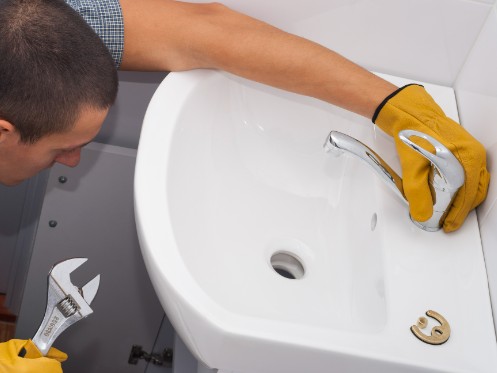There is a difference between repair and emergency repair. Most repairs can happen during regular business hours. An emergency repair is a sudden situation that needs a solution now. That requires a plumber on standby outside of business hours. Another difference is that emergency repairs cost more money than regular repairs. Here are nine situations where the extra cost of a plumbing emergency is nothing compared to stress-free peace of mind.
1. Losing Access to Water
You depend on water to drink, bathe, clean, cook, wash, and flush. Without water, the home can’t perform any errands related to water. That is a tremendous inconvenience. Therefore, no running water is an emergency. A broken valve, water leaks, or a drain clog could cause this. However, a plumber can find out why the water loss is happening in your home and repair it. Contact Cozy Home Services if you suddenly lose access to water.
2. Drain Clogs
Food and grease clog kitchen sinks. Hair, soap scum, small objects, and hard water stains congest the bathroom sink, shower, and bathtub. The water cannot pass through a clog, so it backs into the sink. You’ll notice that once you see a puddle of water inside. It is an emergency because a clog affects the rest of your home’s plumbing system. A plumber will protect your pipes while unclogging the sink drain. DIY methods like drain cleaners and drain snakes destroy plumbing. That makes your situation worse.
3. An Overflowing Toilet
Sadly, most toilet clog situations are not emergencies. You could use another bathroom in the house until you can contact a plumber. A toilet clog is an emergency if that is the only bathroom in the house. The primary emergency is a flooded bathroom. An overflowing toilet is a panicky situation, causing damage to the toilet and weakening the flooring. A plumber can diagnose whether a clog or a float is the problem. The plumber will repair the issue and clean up the wastewater.
The only thing you can do is turn the water supply valve clockwise to the right. That stops more water from entering the toilet and overflowing. Turning off the home’s water supply valve is a backup if the toilet valve doesn’t work.
4. Frozen or Burst Pipes
Another situation that causes flooding is a frozen or burst pipe. While frozen pipes occur in areas where winters are cold, they can happen occasionally in warmer climates. A cold snap can freeze pipes. A sudden influx of water pushing through the ice will burst the pipe. Turning the faucet on will not unthaw them. A plumber can resolve a frozen pipe before it ruptures. Keep the faucet off until then.
High water pressure buildup on the plumbing’s weaker section causes burst pipes. A leak is an example. Old age can also cause them to burst. Burst pipes bring gushes of flowing water to the area within minutes, weakening the walls, ceiling, flooring, and home structure. It can also flood the affected area and tamper with electrical items. If you find a burst pipe, turn off the home’s water supply, remove items in the affected area, and contact a plumber.
5. Water Damage
Overflowing toilets and burst pipes lead to water damage if left unattended. A musty smell, water stains on the ceiling, and discoloration are signs of it. If you notice one, the leak was present for a while. Leaving it unattended can lead to mold growth, wall cracks, and electrical problems. Water damage to the ceiling may cause sagging and a collapse.
6. Sewer Line Backups
One clogged sink drain may not lead to a sewer backup, but multiple clogs will. A clogged toilet and tree roots can also cause a sewer backup. A sewer backup returns wastewater, feces, and other waste from the entire home into the toilet. The smell of hazardous contaminants causes vomiting, gagging, fever, illness, and more. It’s different from an overflowing toilet, as it contains more water than waste.
A soggy backyard or a strong stench is a sign of a faulty sewer line. Another is when water used in one area ends up somewhere else. One example is waste ending up in the kitchen sink when you flush the toilet. Another example is water ending up in the bathtub when you wash your hands in the bathroom sink.
7. Water Heater Failure or Malfunction
No running hot water, a foul odor, and water discoloration are signs of a failing or malfunctioning water heater. An undetected leak spring may be present, draining all the water out of the heater. The leak can cause water damage to the surrounding area. Noise is another reason for water heater failure. A water heater is typically not noisy, so any sound is cause for concern. Consequently, the water heater is the culprit when something serious happens.
What makes a water heater failure a genuine emergency is the time of year. Winter is the worst time to go without hot water. Bathing with cold water is too shocking for the body. That puts kids, pets, and older adults at risk of a jolting reaction. A second water heater emergency is the smell of gas. A third one is the inability to turn the temperature down or switch the power on or off.
8. Gas Line Leaks
You wouldn’t think plumbers deal with gas lines, but they are the ones to call to fix them. Natural gas is odorless, but gas companies add a smell so you know if gas is leaking. Orange flames on the cooktop, hissing or whistling sounds, and a visible cloud are other signs of gas leaks. A gas leak jeopardizes your health and hurts plants in your home. Carbon monoxide poisoning is the worst result, as it can lead to death. Minor health hazards you experience with gas leaks are:
- Skin irritation
- Eye irritation
- Dizziness
- Nosebleeds
- Headaches
- Breathing difficulty
- Malaise
If you experience these symptoms, contact a plumber immediately. Do not use appliances, phones, lighting, candles, matches, or cigarette lighters. Open windows and doors and leave the house immediately. You may have to call 911.
9. Sump Pump Glitches
In your basement or crawlspace lies the sump pump. It removes excess water from the home’s foundation. It is valuable in flood zones or areas with heavy rainfall. A failing sump pump causes water damage. That affects your home’s foundation and structure. Causes of sump pump failure are lack of power, clogs, overheating, and float switch malfunctions. You will know about sump pump failure when you hear noises, see wet spots on walls, notice irregular cycles, and notice the pump continuing to run. A flood of water and mold and mildew are other signs.
Count on Cozy Home Services Emergency 24/7 Service
You can rely on Cozy Home Services for emergency plumbing and sewer situations because we have a 24/7 emergency answering service. Save us on your list of contacts for HVAC repair and replacement. We also offer electrical services, routine maintenance, ductwork, and indoor air quality needs. Ask us about our special offers and financing upon credit approval, too. Contact Cozy Home Services for more information about what we do and the services we can provide for your Vacaville, CA, home.



